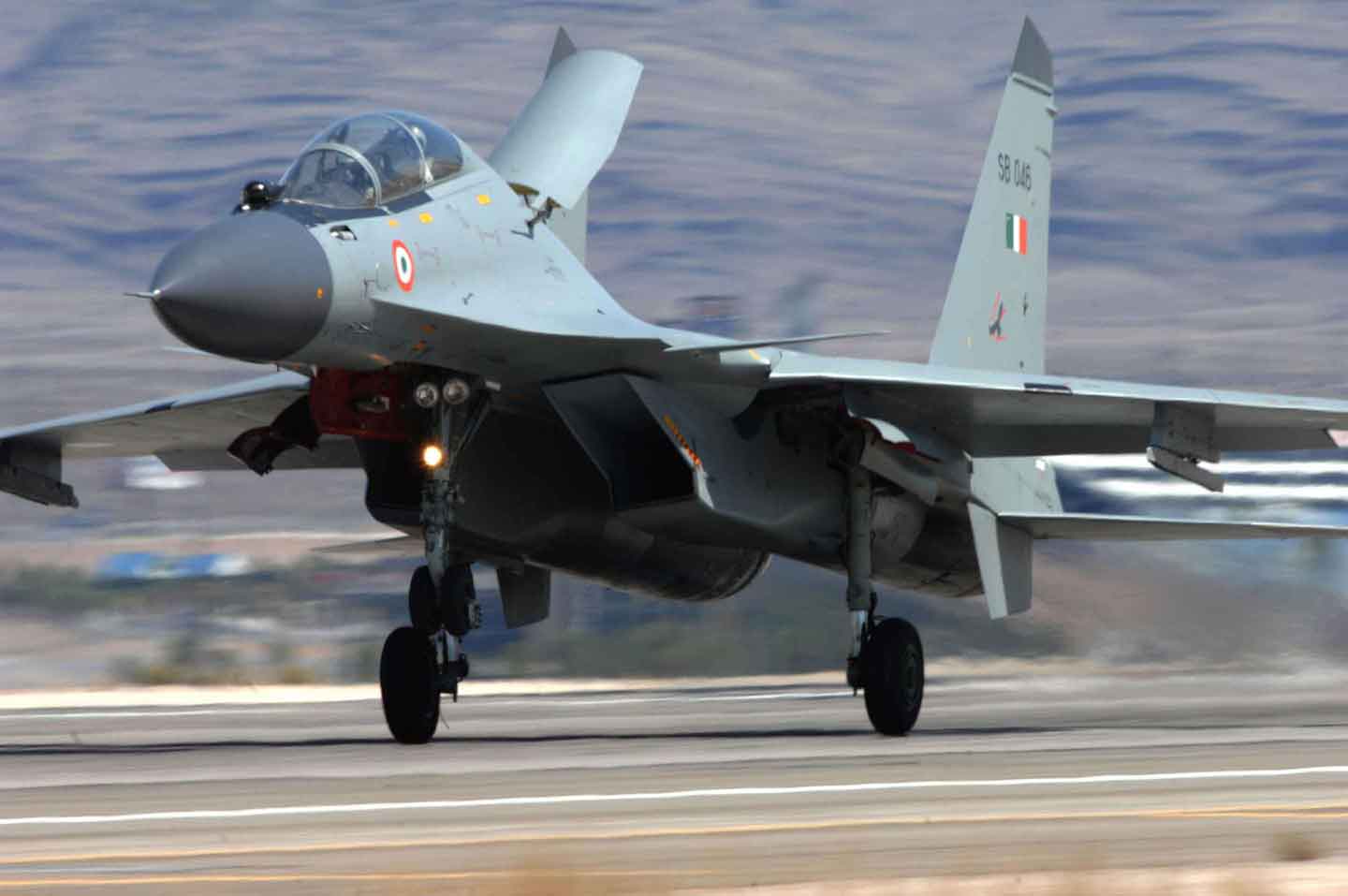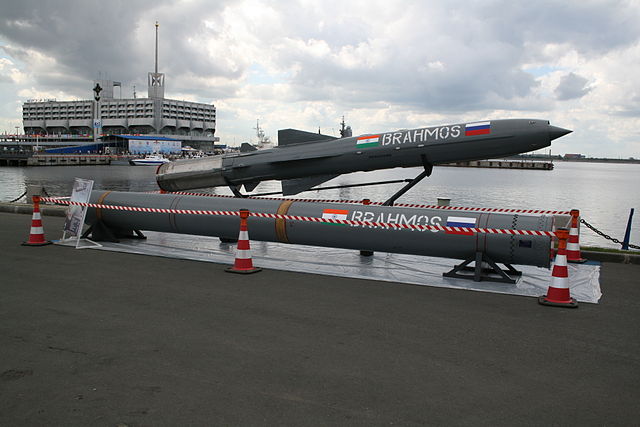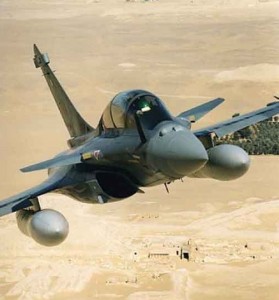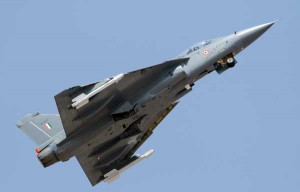The IAF is retaining a combat edge – thanks to increased induction of Su-30MKI fighters and the proposed acquisition of Tejas.
The Indian Air Force’s quick fix solution for its fighter crunch is to crank up production of the Su-30 MKI – the backbone of its combat fleet. India had initially contracted with Russia for 272 Sukhois, but that number will in all probability cross 300 by 2019.
With multiple squadrons of older MiG-21 interceptors and MiG-27 ground attack jets being retired in quick succession, the IAF fighter fleet is set to decline to a low of 32 squadrons – or around 576 aircraft.
With multiple squadrons of older MiG-21 interceptors and MiG-27 ground attack jets being retired in quick succession, the IAF fighter fleet is set to decline to a low of 32 squadrons – or around 576 aircraft. That’s way below the 42 squadrons recommended back in the 1950s.
The scrapping of the 126-aircraft contract with France – plus the delay in the signing of the revised 36-aircraft deal – and the IAF’s lack of confidence in the locally built Tejas have also contributed to the service going in for additional Sukhois.
The faith in the Russian aircraft is justified. With the induction of large numbers of class leading Sukhoi-30 MKI fighters, the IAF has not only made a huge technological transition from a MiG-21 dominated fleet, its war fighting doctrine has also changed, focusing on long-range and strategic missions.
The IAF describes the Sukhoi as its “air dominance fighter” because it allows the service to perform a multiplicity of missions required to keep in step with India’s rising global stature. The Sukhoi’s versatility – owing to its extended range, speed, firepower and super-maneuverability – has given the IAF considerable leeway in deploying the aircraft in offensive missions.
In April 2013 the IAF held its largest-ever combat exercise involving as many as 400 combat aircraft plus 200 transport planes and helicopters. The exercise was aimed at testing the IAF’s capability for a two-front war against China and Pakistan, by deploying “swing forces” from the western theatre right across to the east.
…modern aircraft like the Sukhoi are versatile fighters that not only undertake strike and bombing missions but can also provide combat air patrol, creating a safe envelope for other jets to operate freely.
As part of the war games, Sukhoi-30 MKIs flew 1800 km bombing missions from the northeast to the western front, with mid-air refueling. This is possible because the Sukhoi has a range of 4.5 hours on internal fuel, and IAF pilots are known to lead missions over 10 hours.
Quality vs Quantity
In the 1950s, the defence brass recommended 64 squadrons of fighters for the IAF. That was revised down to 42 in the 1960s. However, modern aircraft like the Sukhoi are versatile fighters that not only undertake strike and bombing missions but can also provide combat air patrol, creating a safe envelope for other jets to operate freely.
What it means is that compared with previous generation aircraft, today you need fewer warplanes to get the same job done. Better survivability and lower maintenance also contribute to more aircraft being available for missions.
Three hundred is an impressive number for such a high-end – and expensive weapons – platform. This shows a keen sense of judgement by the IAF, which realizes that 100 percent fleet utilization is impossible and having a large number of air superiority aircraft around is the key to getting the job done.
With such numbers at its disposal, the IAF is now able to build a network of bases around the country. Earlier, because of the short range of IAF fighter aircraft, most Indian air bases – such as Adampur, Jammu, Amritsar and Jodhpur – were close to the Pakistan border. But now Sukhois are also being stationed at places such as Thanjavur in the deep south, Chabua in the northeast and Pune in western India. Because of its long legs and speed, the Sukhois can move between the Pakistan and China fronts when required.
Missile force-multipliers
Another reason why India is not short of options in a future war is the induction in massive numbers of the BrahMos supersonic missile. This is really India’s Brahmastra or superweapon. The Indo-Russian BrahMos is a highly destructive missile and belongs to a class of missiles that are designed to cut small warships in half. Indian and Russian scientists have modified the cruise missile to strike targets on land.
Hindustan Aeronautics Ltd is carrying out structural modifications on the Sukhois to enable them to carry the air launched variant of the BrahMos. If the contracting firms are able to reduce the mass and weight of the missile, the aircraft would be able to carry up to three of these missiles.
In previous wars the IAF largely avoided attacks on non-military infrastructure, preferring to target tanker farms and defence bases. The decision to equip the Sukhois with the BrahMos creates new synergies and signals a new intent. In the next war expect a lot of damage to enemy infrastructure – dams, power stations and industrial clusters are all likely to be targeted.
…fewer fighter aircraft are needed to fight tomorrow’s wars. So cries of depleting fighter squadrons are a throwback to a bygone era.
Because the BrahMos can strike targets deep inside enemy territory, it frees up fighter aircraft for other roles and different battlefield theatres. It also obviates the need to expose Indian pilots in potentially dangerous missions.
A supersonic BrahMos launched from the Rajasthan border can strike an airbase in Sargodha or Karachi within seconds. Because of its high kinetic impact, it is the ideal weapon to be launched against, say, hardened aircraft pens or communication bunkers. Because the BrahMos hits without warning, it is like a sniper who creates an atmosphere of panic among enemy troops, impacting their morale.
India will also induct the slower, subsonic Nirbhay cruise missile which is intended for attacking targets that can be taken out without the destructive power of the BrahMos. These might include civilian targets.
In this backdrop of a transformed technological scenario, fewer fighter aircraft are needed to fight tomorrow’s wars. So cries of depleting fighter squadrons are a throwback to a bygone era.
After the Rafale rigmarole
The IAF has done an oversell to the Indian public and the political leadership on the Rafale. The French fighter was a viable option a decade ago when India had the chance to lock in 126 aircraft for $10 billion, give or take. However, that’s ancient history. Today the costs have nearly quadrupled.
Still, if the government has made up its mind to indulge the IAF with a smaller 36-aircraft order for $9 billion, then why not.
After all, India spent $8 billion on the shameful, scandalous Commonwealth Games, which made all Indians look grateful to be allowed to acknowledge the doddering British queen as the head of this anachronistic organisation.
At least the Rafale will bring some gains to India in terms of high technology and – perhaps optimistically – defence offsets. Plus, the IAF fleet will have four advanced fighter aircraft, including the Sukhoi, MiG-29 and Mirage 2000, thereby complicating Pakistan’s defence planning. It will almost certainly spur additional wasteful spending by Pakistan, which is never a bad idea from India’s point of view.
Looking forward to Tejas
Tejas was one of the stars at the air show in Bahrain this month. That it performed without a hitch at a foreign air show is the aeronautical equivalent of human evolution from ape to homo sapien. It’s nothing less than a miracle.
Like Russia’s Sukhoi and MiG series and American F-series aircraft, the Tejas can also evolve into a potent fighter with backing from the IAF and the Indian Navy. By, say 2030, when the Sukhois retire, the Tejas should be able to take over their role. For that the government should get rid of the foreign import mafia that lives on defence commissions. (BrahMos director A. Sivathanu Pillai has written in his book ‘The Path Unexplored’ how he checkmated serving military generals who attempted to scuttle the missile.)
In the meantime, the 300 Sukhois – and the support cast of 59 MiG-29s, 48 Mirage 2000s and upgraded MiG-21s – are more than enough to defend the country and fight a prolonged war.









Better analysis was expected of him unless he has ulterior motive to keep India weak. India has to prepare for the combined force of Chinki liars and Paki thugs. We need far bigger and superior fleet to defend ourselves. Trust in Tejas is irresponsible and downright stupidity, when we cannot even manufacture engines.
Mr. Rakesh Simha has really a poor understanding of military strength, and so his analysis is nonsense. He has presented no comparison of force power build up by Pakistan and China, and is comparing the force power of today’s aircraft to those of yesterday. As such, he is anachronistic in his approach. By claiming that India can do with only a little more than 400 aircraft, he has a secret desire to see India go down. He is obviously playing to politicians who want to take away funding from the military/IAF. After reading his article, it appears he does not have the best interests of India at heart.